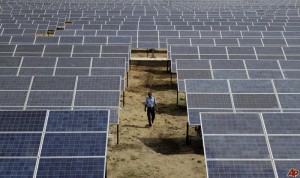Clean vs Dirty Energy: Learning From India’s Great Blackout
Aug 22nd, 2012 | By admin | Category: Energy and Carbon EmissionsBy Suzanne York, www.howmany.org.
India is a fast-developing nation with a population of 1.2 billion people, and by 2030 will likely be the most-populous in the world.
India’s disparities and inequalities are staggering, with 32.7% of the population living on $1.25 per day. As the country continues to grow, the impacts on its citizens and the environment become more severe.
Take energy, for an example. Over 400 million Indians lack access to the modern electrical grid. Approximately 70% of India’s power comes from coal and it has the world’s fifth-largest coal reserves. India is the third-largest coal producer in the world, but also the third-largest importer. Earlier this year the IMF reported that coal causes about 70,000 premature deaths every year in India. The country has the worst air pollution in the entire world. Continued dependence on coal is only going to exacerbate health problems.
What happens when the electric grid fails and nearly 700 million Indians are left in the dark, as happened in early August when a massive power failure occurred? Hopefully an assessment of how best to address the power needs of the sub-continent. This is a pivotal moment. India can take the initiative and invest more in efficiency and renewable energy/off-grid alternatives, beginning a transition off of coal, or it could continue to rely on the dirtiest of fossil fuels, harming communities and environment alike.
The Indian government does have an ambitious plan for increasing solar energy. In 2008 the government launched the National Solar Mission, which calls for generating 12.5 % of India’s total electricity, or 20 gigawatts (GW), from renewable resources by 2020. It was reported last month that the country crossed the 1 GW mark in solar photovoltaic power.
India’s National Action Plan on Climate Change of 2008 states that “Solar energy, therefore, has great potential as future energy source. It also has the advantage of permitting the decentralized distribution of energy, thereby empowering people at the grassroots level.”
Recently the sunny state of Gujarat announced a “rooftop solar power plant policy to enable the people to produce their own electricity and earn money by selling surplus power to the grid”. Over in Uttar Pradesh, the government has also initiated a solar policy, noting that “The State of Uttar Pradesh is endowed with vast potential of solar power and the Government is keen to tap this resource to improve the availability of power in the State by promoting the establishment of solar energy based power projects, both grid connected and off-grid type.”
There are also many entrepreneurs creating clean energy models targeted at the poor. Selco Solar, founded by social entrepreneur Harish Hande, wants to dispel the myth that poor people cannot afford sustainable technologies. The company is focused on bringing affordable electricity from renewable energy to the rural poor and at the same time raise income levels. Others, such as Husk Power Systems, are converting rice husk waste into affordable off-grid energy for rural villages.
Ironically, during India’s big blackout, rural villagers ended up being better off, due to many homes already having solar panels in place. The lesson that should be learned is that reliance on fossil fuels and an old and ailing grid that cannot accommodate growing demand is to jump-start a clean energy future beneficial to all. As energy becomes more costly and scarce, inequality becomes a major issue, something that India must overcome. Decentralized, off-grid renewable energy offers the poor access to more affordable energy.
Even the International Finance Corporation, part of the World Bank Group, just launched a program targeted at “providing safe, clean and affordable off-grid lighting to two million people living in rural India.” The IFC estimates that beyond the 400 million people in India who have no access to energy, another 420 million people have minimal grid supply, driving them to expensive, inefficient and hazardous fuel-based lighting. India spends an estimated $2.2 billion annually on kerosene for lighting, showing the large market potential for off-grid lighting.
Despite the positive initiatives concerning renewable energy, the old guard is still pushing coal and investing in new coal plants even as it becomes more expensive.
Coal mining is also a threat to the endangered Bengal tiger and other species, and rural communities. A recent report by Greenpeace said that 1.1 million hectares of forests in central India are under threat from coal mining; these places are home to 35% of India’s tiger population. There are only about 1,700 wild tigers left in India, and estimates of how long India’s supply of coal is likely to last range from 30 to 200 years.
Of course, as long as the population of India continues to increase by 1.4% annually and the economy continues to modernize, there will be strong economic and political forces demanding utilization of all available power sources.
India and the world can continue to mine for coal, knowing that it will destroy land, species, and communities. Or global society can determine to take bold action and seriously invest in clean energy and put the needs of current and future generations first. Reliance on coal and fossil fuels will continue for the foreseeable future, but supporting diversified and alternative energy sources is the direction in which society should head.
Suzanne York is a senior writer with the Institute for Population Studies/HowMany.org

